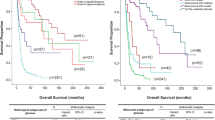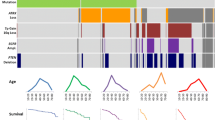Abstract
Since the World Health Organization 2016 classification (2016 WHO), genetic status has been incorporated into the diagnosis of Grade 2/3 gliomas (lower-grade gliomas). Therefore, immunohistochemistry (IHC) of IDH1-R132H, ATRX, and p53 have been used in place of genetic status. We report the associations between histological findings, IHC, and genetic status. We performed IHC of IDH1-R132H, ATRX, and p53 in 76 lower-grade gliomas and discussed its validity based on the 2016 WHO and the upcoming 2021 WHO classification. The sensitivity and specificity of anti-ATRX, p53, and IDH1-R132H IHC were 40.9%/98.1%, 78.6%/85.4%, and 90.5%/84.6%, respectively. Among 21 IDH1-mutant gliomas without 1p/19q codeletion, two gliomas (9.5%) mimicked the so-called classic for oligodendroglioma (CFO) in their morphology. Of the 42 gliomas with 1p/19q codeletion, four cases were difficult to diagnose as oligodendroglioma through morphological examination. Moreover, there were three confusing cases with ATRX mutations but with retained ATRX-IHC positivity. The lessons learned from this study are as follows: (1) ATRX-IHC and p53-IHC should be supplementary to morphological diagnosis, (2) rare IDH mutations other than IDH1 R132H should be considered, and (3) there is no complete alternative test to detect molecular features of glioblastoma under the 2021 WHO classification.



Similar content being viewed by others
References
Louis DN, Perry A, Reifenberger G et al (2016) The 2016 World health organization classification of tumors of the central nervous system: a summary. Acta Neuropathol 131:803–820
Louis DN, Wesseling P, Paulus W et al (2018) cIMPACT-NOW update 1: not otherwise specified (NOS) and not elsewhere classified (NEC). Acta Neuropathol 135:481–484
Louis DN, Giannini C, Capper D et al (2018) cIMPACT-NOW update 2: diagnostic clarifications for diffuse midline glioma, H3 K27M-mutant and diffuse astrocytoma/anaplastic astrocytoma, IDH-mutant. Acta Neuropathol 135:639–642
Brat DJ, Aldape K, Colman H et al (2018) cIMPACT-NOW update 3: recommended diagnostic criteria for “Diffuse astrocytic glioma, IDH-wildtype, with molecular features of glioblastoma, WHO grade IV.” Acta Neuropathol 136:805–810
Ellison DW, Hawkins C, Jones DTW et al (2019) cIMPACT-NOW update 4: diffuse gliomas characterized by MYB, MYBL1, or FGFR1 alterations or BRAF(V600E) mutation. Acta Neuropathol 137:683–687
Brat DJ, Aldape K, Colman H et al (2020) cIMPACT-NOW update 5: recommended grading criteria and terminologies for IDH-mutant astrocytomas. Acta Neuropathol 139:603–608
Louis DN, Wesseling P, Aldape K et al (2020) cIMPACT-NOW update 6: new entity and diagnostic principle recommendations of the cIMPACT-Utrecht meeting on future CNS tumor classification and grading. Brain Pathol 30:844–856
Ellison DW, Aldape KD, Capper D et al (2020) cIMPACT-NOW update 7: advancing the molecular classification of ependymal tumors. Brain Pathol 30:863–866
Paulus W (2017) WHO 2016: Open questions and practical implications. Acta Neurochir (Wien) 159:419–422
Pekmezci M, Rice T, Molinaro AM et al (2017) Adult infiltrating gliomas with WHO 2016 integrated diagnosis: additional prognostic roles of ATRX and TERT. Acta Neuropathol 133:1001–1016
Gorovets D, Kannan K, Shen R et al (2012) IDH mutation and neuroglial developmental features define clinically distinct subclasses of lower grade diffuse astrocytic glioma. Clin Cancer Res 18:2490–2501
Kefenie H, Desta B, Abebe A et al (1989) Prevalence of hepatitis B infection among hospital personnel in Addis Ababa (Ethiopia). Eur J Epidemiol 5:462–467
Cairncross G, Wang M, Shaw E et al (2013) Phase III trial of chemoradiotherapy for anaplastic oligodendroglioma: long-term results of RTOG 9402. J Clin Oncol 31:337–343
Louis DN, Perry A, Wesseling P et al (2021) The 2021 WHO classification of tumors of the central nervous system: a summary. Neuro Oncol 23:1231–1251
Yamamichi A, Ohka F, Aoki K et al (2018) Immunohistochemical ATRX expression is not a surrogate for 1p19q codeletion. Brain Tumor Pathol 35:106–113
Suzuki H, Aoki K, Chiba K et al (2015) Mutational landscape and clonal architecture in grade II and III gliomas. Nat Genet 47:458–468
Aoki K, Natsume A (2019) Overview of DNA methylation in adult diffuse gliomas. Brain Tumor Pathol 36:84–91
Kato Y (2015) Specific monoclonal antibodies against IDH1/2 mutations as diagnostic tools for gliomas. Brain Tumor Pathol 32:3–11
Fujii Y, Ogasawara S, Oki H et al (2015) A high-sensitive HMab-2 specifically detects IDH1-R132H, the most common IDH mutation in gliomas. Biochem Biophys Res Commun 466:733–739
Takami H, Yoshida A, Fukushima S et al (2015) Revisiting TP53 mutations and immunohistochemistry–a comparative study in 157 diffuse gliomas. Brain Pathol 25:256–265
Giannini C, Burger PC, Berkey BA et al (2008) Anaplastic oligodendroglial tumors: refining the correlation among histopathology, 1p 19q deletion and clinical outcome in Intergroup Radiation Therapy Oncology Group Trial 9402. Brain Pathol 18:360–369
Sonoda Y, Yokoo H, Tanaka S et al (2019) Practical procedures for the integrated diagnosis of astrocytic and oligodendroglial tumors. Brain Tumor Pathol 36:56–62
Hewer E, Vajtai I, Dettmer MS et al (2016) Combined ATRX/IDH1 immunohistochemistry predicts genotype of oligoastrocytomas. Histopathology 68:272–278
Takano S, Ishikawa E, Sakamoto N et al (2016) Immunohistochemistry on IDH 1/2, ATRX, p53 and Ki-67 substitute molecular genetic testing and predict patient prognosis in grade III adult diffuse gliomas. Brain Tumor Pathol 33:107–116
Leeper HE, Caron AA, Decker PA et al (2015) IDH mutation, 1p19q codeletion and ATRX loss in WHO grade II gliomas. Oncotarget 6:30295–30305
Rajeswarie RT, Rao S, Nandeesh BN et al (2018) A simple algorithmic approach using histology and immunohistochemistry for the current classification of adult diffuse glioma in a resource-limited set-up. J Clin Pathol 71:323–329
Grillo F, Bruzzone M, Pigozzi S et al (2017) Immunohistochemistry on old archival paraffin blocks: is there an expiry date? J Clin Pathol 70:988–993
Combs SE, Han G, Mani N et al (2016) Loss of antigenicity with tissue age in breast cancer. Lab Invest 96:264–269
Rajmohan KS, Sugur HS, Shwetha SD et al (2020) Alpha internexin: a surrogate marker for 1p/19q codeletion and prognostic marker in anaplastic (WHO grade III) Gliomas. Neurol India 68:832–837
Kitahama K, Iijima S, Sumiishi A et al (2021) Reduced H3K27me3 levels in diffuse gliomas: association with 1p/19q codeletion and difference from H3K27me3 loss in malignant peripheral nerve sheath tumors. Brain Tumor Pathol 38:23–29
Acknowledgements
This research was supported by a Grant-in-Aid for Scientific Research on Innovative Areas “Chemistry for Multimolecular Crowding Biosystems” (A.N.) (JSPS KAKENHI Grant No. 17928985). This research was also supported in part by the Japan Agency for Medical Research and Development (AMED) under Grant Number: JP21am0101078 (to Y.K.).
Funding
Japan Society for the Promotion of Science,17928985,Atsushi Natsume,Japan Agency for Medical Research and Development,JP21am0101078,Yukinari Kato
Author information
Authors and Affiliations
Contributions
Conceptualization: A.N., R.W. and I.I.; Methodology: A.N., A.Y., K.M., Y. Kitano, R.W., and I.I.; Conduct of Immunohistochemistry: S.S. and T.O.; Formal analysis and investigation: Y. Kitano, A.Y. S.M., Y.K., A.K., R.S., T. W., R.W., and I.I.; Writing-original draft preparation: T.N., R.W., and I.I.; Writing-review and editing: R.W., I.I., and A.N.; Funding acquisition: A.N. and Y. Kato; Resources: Y.M., F.O., K.A., M.M., J.Y., Y. Kitano and Y. Kato; Supervision: A.N. and I.I.
Corresponding authors
Additional information
Publisher's Note
Springer Nature remains neutral with regard to jurisdictional claims in published maps and institutional affiliations.
Rights and permissions
About this article
Cite this article
Nishikawa, T., Watanabe, R., Kitano, Y. et al. Reliability of IDH1-R132H and ATRX and/or p53 immunohistochemistry for molecular subclassification of Grade 2/3 gliomas. Brain Tumor Pathol 39, 14–24 (2022). https://doi.org/10.1007/s10014-021-00418-x
Received:
Accepted:
Published:
Issue Date:
DOI: https://doi.org/10.1007/s10014-021-00418-x




